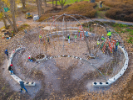Latest design-build project adds to Silo City’s regenerating landscape
by David J. Hill
Published January 6, 2021 This content is archived.
In a barren field in the shadows of towering grain elevators at Silo City, a group of University at Buffalo architecture students have created a beautiful structure that will continue to evolve and take shape. And they did it amid the stops and starts of the COVID-19 pandemic.
Having the satisfaction of finishing a design-build in a pandemic, being able to see it finished and say that I was a part of creating the creation is the reason why I’m so passionate about architecture,” said Adara Zullo, a student in the UB School of Architecture and Planning fall studio that saw the project to completion.
Their work centers on a 60-foot diameter trellis composed of stainless steel viper tubing manufactured by Rigidized Metals. The CEO of Rigidized Metals, Rick Smith, owns Silo City, a sprawling collection of grain elevators along the Buffalo waterfront. UB School of Architecture and Planning faculty and students have collaborated with Rigidized Metals on numerous projects at Silo City over the years.
The trellis will train the branches of willow trees planted beneath to form a canopied natural gathering space. Over time, the willows will intertwine and graft together to become a single structure.
“The hope is that when the willows start growing, they’ll kind of overtake the structure and form this dome shape, and that this will become a gathering space for people at Silo City,” said Joyce Hwang, associate professor of architecture, who taught the studio in spring 2020.
Coronavirus delayed construction
COVID-19 pushed the construction phase of the project back to fall 2020, and that’s where a studio led by Nicholas Rajkovich, PhD, associate professor of architecture at UB, guided the project to completion.
To ensure everyone’s safety and reduce the number of people on-site, Rajkovich had the students work in teams, alternating days at Silo City. They completed the structure in early December.
“I am still just so amazed you all were able to pull this off, and how organized and diligent Nick was in keeping everyone safe,” Hwang told the students in December during a studio wrap-up presentation that took place virtually. “Despite everything that’s going on in 2020, this is definitely one of the highlights. It’s been a real treat to be part of this process, and I’m so happy that this actually happened safely and that it’s looking amazing.”
A secondary piece of the course included the creation of a field guide mapping the ecology of Silo City, including mammals, soil, water, ectotherms and invertebrates. Each student chose an ecological area to research and report on.
“I’m very proud of our students. They finished the structure and also created a field guide to Silo City, which builds on the work that’s been happening there for the last 30-plus years,” said Rajkovich. “It’s certainly been an exciting semester.”
Simple beginnings
About 50 people have touched the project in some way since fall 2019. At that time, the idea was simply to cover a water pump by a pond at Silo City. But the fall 2019 studio — co-taught by Laura Garofalo, who is now at Carnegie Mellon University — shifted it toward finding a way to eradicate Japanese knotweed, an invasive plant species that was growing in parts of Silo City.
The goal then became designing and building an architectural intervention that would contribute to the ongoing effort to regenerate Silo City’s post-industrial landscape.
In late fall 2019, students presented their concepts at Silo City, with a final design selected for construction and development.
“After three semesters of design, revision and construction, the final vision still has yet to be achieved, but the structure is complete,” said Mitchel Mesi, a graduate student in this fall’s studio. “After the ecology is regenerated and the green plant life is in place, the project will continue to grow and be maintained. I think that these kinds of things are never truly complete, so it’ll be very interesting to watch as it continues to grow.”
Elizabeth Gilman, an architecture master’s student, has been involved with the project over the course of its three semesters of development.
'Amazed to see how far this project has come.'
“I’m just amazed to see how far this project has come,” she said. “It’s been such an amazing experience to watch a project go from a sketch all the way through construction.”
From the beginning, this project has been about integrating architecture and nature, creating an infrastructure for habitat and putting growth on display, she said.
“I’m excited to see this next phase, with planting all of the willows and activating this metal structure we’ve created with all the plants,” she said.
The students’ progress, including early design sketches, has been documented on newnatures_buffalo, the Instagram account of the School of Architecture and Planning’s ecological practices research group.
It was an early Instagram post that captured the attention of Lovepreet Kaur, causing her to switch from another architecture studio to the Ecological Practices Graduate Research Group.
Kaur contributed to the field guide by researching herbaceous plants at Silo City.
“I learned that mudwort can be used as a natural health remedy,” Kaur said, adding, “Also, you will never win the war against Japanese knotweed.”
Kaur recalled what it was like spending time amidst the natural landscape of Silo City: “I had never made a field guide before so this was a very fun process of observing, drawing and writing down notes while sitting on the ground, listening to the sound of trees and the buzzing of mosquitoes.”
Joshua Smith, Rigidized Metals’ director of ecology, said the project is already beginning to get attention.
“People are freaking out. Everyone wants to come down and see it but they can’t right now,” he said. “It’s definitely going to be a popular destination.”







